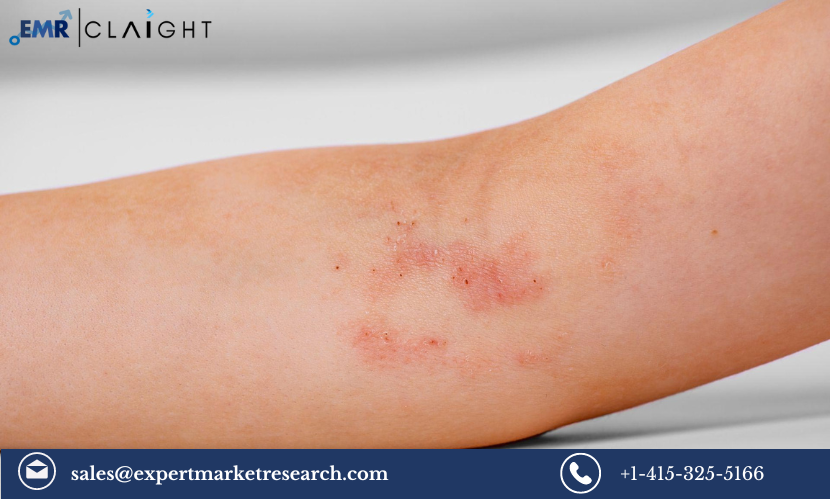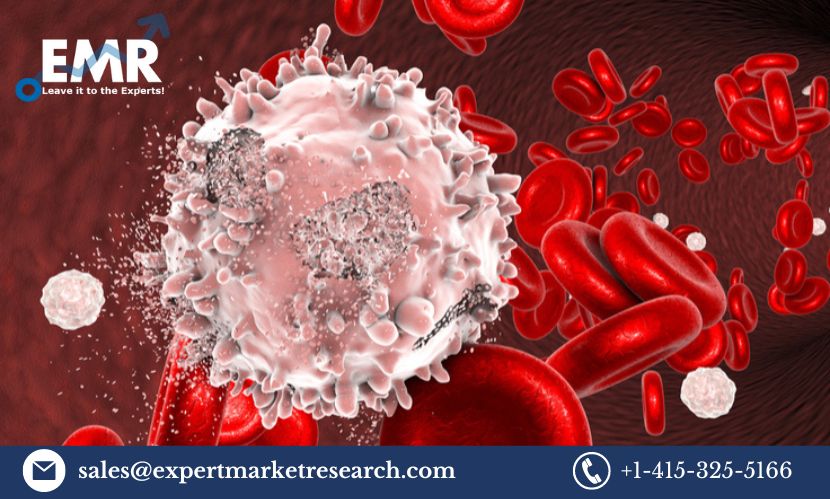The atopic dermatitis market size was valued at USD 9.33 billion in 2023, driven by the growing prevalence of dermatological skin disorders across 8 major markets. The market is expected to grow at a CAGR of 15.10% during the forecast period of 2024-2032, with the values likely to rise from USD 10.73 billion in 2024 to USD 33.07 billion by 2032.
Atopic dermatitis, also known as eczema, is a common and chronic inflammatory skin condition that affects up to 20% of children and 10% of adults worldwide. It is characterized by dry, itchy, red and inflamed skin that can cause significant impairment in quality of life and increase the risk of secondary infections and comorbidities. The mainstay of treatment for atopic dermatitis is topical corticosteroids, which are effective in reducing inflammation and symptoms, but have limited long-term efficacy and potential adverse effects. Other topical agents, such as calcineurin inhibitors and PDE4 inhibitors, are also used for moderate to severe cases, but have safety concerns and high costs. Systemic therapies, such as immunosuppressants and biologics, are reserved for the most severe and refractory cases, but have limited availability and accessibility in many regions. The unmet need for safe, effective and convenient therapies for atopic dermatitis is driving the growth of the market, as well as the increasing prevalence and awareness of the condition, the rising disposable income and healthcare expenditure, and the growing demand for personalized and targeted treatments.
Epidemiology
The prevalence of atopic dermatitis varies widely across regions and populations, depending on genetic, environmental and lifestyle factors. The incidence of atopic dermatitis is increasing in many regions, especially in urban areas and industrialized countries, due to changes in environmental factors, such as pollution, allergens, hygiene and climate, and lifestyle factors, such as diet, stress and smoking.
| Global Prevalence | Population Affected | Adults Affected | Children Affected | Female Prevalence | Female Population Affected | Male Prevalence | Male Population Affected |
| 2.6% [95% UI 1.9–3.5] | 204.05 million | 101.27 million | 102.78 million | 2.8% [95% UI 2.0–3.7%] | 108.29 million | 2.4% [95% UI 1.7–3.3%] | 95.76 million |
Get a Free Sample Report with a Table of Contents:https://www.expertmarketresearch.com/reports/atopic-dermatitis-market
Key Drivers and Constraints
The key drivers of the atopic dermatitis market are:
- The high unmet need for safe, effective and convenient therapies for atopic dermatitis, especially for moderate to severe cases that are inadequately controlled by topical agents.
- The increasing prevalence and awareness of atopic dermatitis, as well as the growing recognition of its impact on quality of life and comorbidities.
- The rising disposable income and healthcare expenditure, especially in emerging markets, such as China, India and Brazil, where the demand for atopic dermatitis treatments is growing.
- The growing demand for personalized and targeted treatments, as well as the development of novel biomarkers and diagnostic tools, that can identify the underlying mechanisms and subtypes of atopic dermatitis and guide the optimal treatment choice and response.
- The robust pipeline of innovative therapies for atopic dermatitis, including biologics, small molecules, monoclonal antibodies, gene therapies and topical agents, that have shown promising results in clinical trials and have the potential to address the unmet needs of the market.
The key constraints of the atopic dermatitis market are:
- The high cost and limited accessibility of some of the novel therapies, especially biologics, that may limit their adoption and penetration in the market, especially in low- and middle-income countries.
- The lack of standardized and validated outcome measures and endpoints for atopic dermatitis, that may hamper the comparison and evaluation of the efficacy and safety of different therapies and the regulatory approval process.
- The heterogeneity and complexity of atopic dermatitis, that may pose challenges in the identification and stratification of the patient population and the optimization of the treatment regimen and duration.
- The low adherence and compliance of patients to the prescribed therapies, due to the chronic and relapsing nature of atopic dermatitis, the inconvenience and adverse effects of some of the treatments, and the lack of patient education and support.
- The competition and patent expiry of some of the existing therapies, such as topical corticosteroids and calcineurin inhibitors, that may reduce the market share and revenue of the innovator companies and increase the availability of generic and biosimilar alternatives.
Key Trends and Developments
The key trends and developments in the atopic dermatitis market are:
| Topic | Details |
| New therapies | The emergence of new therapies that target specific pathways and mechanisms involved in the pathogenesis of atopic dermatitis, such as interleukin (IL)-4, IL-13, IL-31, and JAK inhibitors. These therapies have shown promising efficacy and safety results in clinical trials and have the potential to address the unmet needs of patients with moderate-to-severe disease who do not respond well to conventional treatments. |
| Adoption of biologics and systemic therapies | The increasing adoption of biologics and systemic therapies for atopic dermatitis, especially in the US and Europe, where regulatory approvals and reimbursement policies have been favorable for these products. Biologics and systemic therapies offer more convenient and effective options for patients who require long-term treatment and have a high burden of disease. |
| Growing awareness and education | The growing awareness and education among patients and healthcare providers about the diagnosis, management, and prevention of atopic dermatitis, as well as the availability of online and offline resources and support groups that provide information and guidance for patients and caregivers. These initiatives can help improve the quality of life and adherence of patients with atopic dermatitis and reduce the associated costs and complications. |
Read Full Report with Table of Contents: https://www.expertmarketresearch.com/reports/atopic-dermatitis-market
Market Segmentation
The atopic dermatitis market can be segmented by drug class, route of administration, and region.
| Segment | Categories | Description |
| Drug Class | PDE4 Inhibitors, Biologics, Others | PDE4 inhibitors target inflammation, reducing symptoms like itching and redness. Biologics, used in severe cases, modulate the immune system by blocking specific proteins. |
| Route of Administration | Oral, Topical, Injectables | Reflects different methods of medication administration available for atopic dermatitis: orally taken drugs, creams or ointments applied to the skin, and drugs administered via injection. |
| Region | United States, EU-4 and the United Kingdom (Germany, France, Italy, Spain, United Kingdom), Japan, China | Covers major markets with significant growth forecast. North America leads, with high awareness and prevalence of atopic dermatitis, and a robust healthcare system. |
Competitive Landscape
The competitive landscape of the atopic dermatitis market is characterized by intense competition among pharmaceutical companies, biotechnology firms, and research institutions aiming to develop and commercialize effective treatments for this chronic skin condition. Key players involved in the market are AbbVie Inc., Astellas Pharma Inc., Bayer AG, Bristol Myers Squibb Inc., Eli Lilly and Company Inc., Galderma Inc., Pfizer Inc., Novartis AG, Viatris Inc., Sanofi SA, Regeneron Pharmaceuticals, Inc., Leo Pharma, Inc., Incyte Corporation, Inc., Arcutis Biotherapeutics, Inc., and Asana Biosciences, Inc.
Key factors shaping this landscape include the development of novel therapeutics, strategic collaborations, and an emphasis on targeting unmet medical needs within the atopic dermatitis patient population.
| Company | Announcement Date | Collaboration/ Acquisition/ Trial | Details |
| Sanofi and Regeneron | July 2020 | Collaboration | Discover, develop and commercialize up to eight novel antibody-based therapies for inflammatory and autoimmune diseases, including atopic dermatitis. The collaboration will leverage Regeneron’s VelocImmune technology and Sanofi’s expertise in immunology and drug development. |
| Pfizer | June 2020 | Acquisition | Completed the acquisition of Anacor Pharmaceuticals, a biopharmaceutical company focused on developing and commercializing novel small molecule therapeutics for inflammatory and rare diseases, including atopic dermatitis. Pfizer gained access to Anacor’s lead product candidate, crisaborole, a topical non-steroidal anti-inflammatory drug that is under review by the US Food and Drug Administration (FDA) for the treatment of mild to moderate atopic dermatitis. |
| Eli Lilly | April 2020 | Trial | Initiated a phase 3 clinical trial of lebrikizumab, a monoclonal antibody that targets interleukin-13, a key cytokine involved in the pathogenesis of atopic dermatitis. The trial will enroll approximately 736 adult and adolescent patients with moderate to severe atopic dermatitis who have an inadequate response to topical corticosteroids or are intolerant to them. The primary endpoint of the trial is the percentage of patients achieving Investigator Global Assessment (IGA) 0/1 and at least a 2-point improvement at 16 weeks. |
Read more report:
Smart Implants Market – https://www.expertmarketresearch.com/reports/smart-implants-market
Medical Cannabis Market – https://www.expertmarketresearch.com/reports/medical-cannabis-market
Biosensors Market – https://www.expertmarketresearch.com/reports/biosensors-market
About Us:
Acquire unparalleled access to critical industry insights with our comprehensive market research reports, meticulously prepared by a team of seasoned experts. These reports are designed to equip decision-makers with an in-depth understanding of prevailing market trends, competitive landscapes, and growth opportunities.
Our high-quality, data-driven analyses provide the essential framework for organizations seeking to make informed and strategic decisions in an increasingly complex and rapidly evolving business environment. By investing in our market research reports, you can ensure your organization remains agile, proactive, and poised for success in today’s competitive market.
Don’t miss the opportunity to elevate your business intelligence and fortify your strategic planning. Secure your organization’s future success by acquiring one of our Expert Market Research reports today.
Media Contact:
Company Name: Claight Corporation
Contact Person: Robin Johnson, Business Consultant
Email: sales@expertmarketresearch.com
Toll-Free Number: US +1-415-325-5166 | UK +44-702-402-5790
Address: 30 North Gould Street, Sheridan, WY 82801, USA
Website: www.expertmarketresearch.com



